Samsung S 16-50mm f/2-2.8 ED OIS Review

Introduction
The Samsung S 16-50mm f/2-2.8 ED OIS is a professional standard zoom lens for Samsung's range of compact system cameras. The optical formula comprises 18 elements in 12 groups, including 3 aspherical, 2 ED (extra-low dispersion) and 2 XHR (eXtreme High Refractive) elements, and it boasts a dust-proof and water-resistant design. Weighing in at 622 grams, the Samsung S 16-50mm f/2-2.8 ED OIS lens also features Samsung's Optical Image Stabilisation technology to combat blurring that may result from shaky hands. The Samsung S 16-50mm f/2-2.8 ED OIS lens is currently available for £1000 / $1299.99 in the UK and the US, respectively.
Ease of Use
Tipping the scales at 622 grams, the Samsung S 16-50mm f/2-2.8 ED OIS is a big and heavy lens. It's much more at home on a the larger camera body like the new NX1, rather than a smaller one such as the Samsung NX3000 that we tested it with.
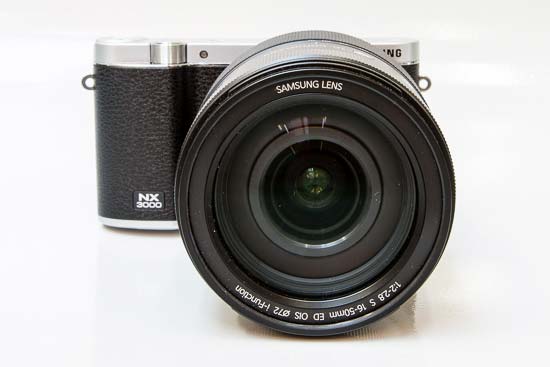 The Samsung S 16-50mm f/2-2.8 ED OIS lens mounted on a Samsung NX3000 body
The Samsung S 16-50mm f/2-2.8 ED OIS lens mounted on a Samsung NX3000 body
 The Samsung S 16-50mm f/2-2.8 ED OIS lens mounted on a Samsung NX3000 body
The Samsung S 16-50mm f/2-2.8 ED OIS lens mounted on a Samsung NX3000 body
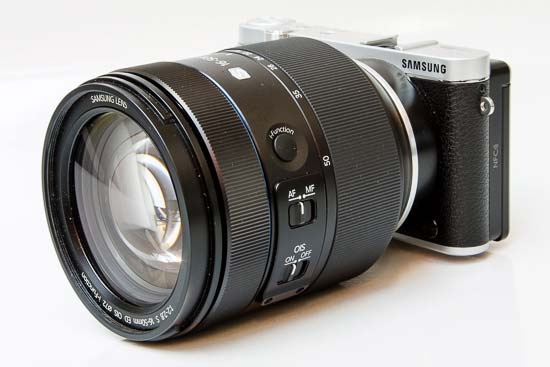 The Samsung S 16-50mm f/2-2.8 ED OIS lens mounted on a Samsung NX3000 body
The Samsung S 16-50mm f/2-2.8 ED OIS lens mounted on a Samsung NX3000 body
 The Samsung S 16-50mm f/2-2.8 ED OIS lens mounted on a Samsung NX3000 body
The Samsung S 16-50mm f/2-2.8 ED OIS lens mounted on a Samsung NX3000 body
Build quality is very good, with a metal bayonet mount, smooth focus and zoom rings, and very little wobble even when fully extended.
 The side of the Samsung S 16-50mm f/2-2.8 ED OIS lens
The side of the Samsung S 16-50mm f/2-2.8 ED OIS lens
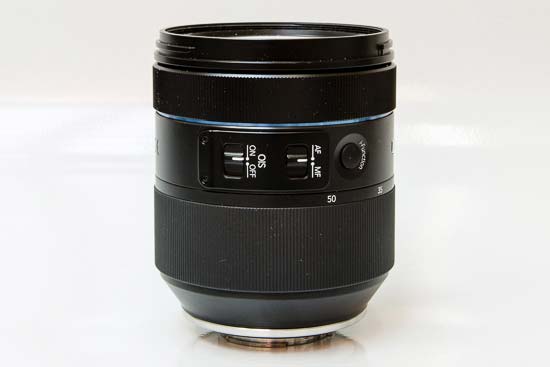 The side of the Samsung S 16-50mm f/2-2.8 ED OIS lens
The side of the Samsung S 16-50mm f/2-2.8 ED OIS lens
 The side of the Samsung S 16-50mm f/2-2.8 ED OIS lens, zoomed out
The side of the Samsung S 16-50mm f/2-2.8 ED OIS lens, zoomed out
Zooming is not internal – as you can see, the front of the Samsung S 16-50mm f/2-2.8 ED OIS extends cupon zooming to the full 50mm telephoto setting. The ribbed zoom ring is sufficiently wide and neither too stiff nor too loose.
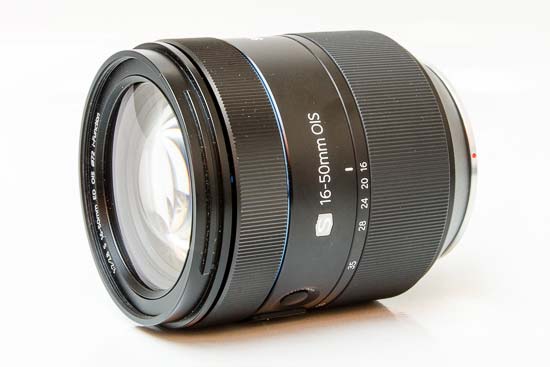 The front of the Samsung S 16-50mm f/2-2.8 ED OIS lens
The front of the Samsung S 16-50mm f/2-2.8 ED OIS lens
 The rear of the Samsung S 16-50mm f/2-2.8 ED OIS lens
The rear of the Samsung S 16-50mm f/2-2.8 ED OIS lens
The Samsung S 16-50mm f/2-2.8 ED OIS's feature set includes a quiet focus motor, an Ultra-Precise Stepping Motor (UPSM), an auto/manual focus switch and Samsung's Vibration Reduction (VR) image stabilisation system.
Samsung's now standard i-Function button is also present and correct, an innocuous looking button on the lens barrel which when pressed activates a sub-menu of key options and allows you to change them simply by turning the focus ring.
There is no distance scale, focus limiter or depth-of-field scale.
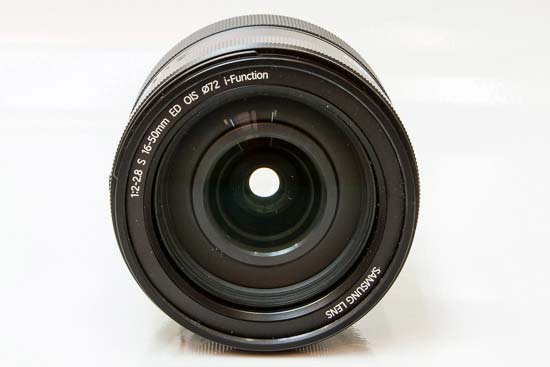 The front of the Samsung S 16-50mm f/2-2.8 ED OIS lens
The front of the Samsung S 16-50mm f/2-2.8 ED OIS lens
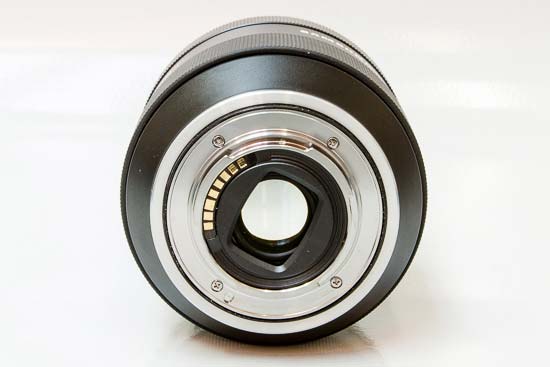 The rear of the Samsung S 16-50mm f/2-2.8 ED OIS lens
The rear of the Samsung S 16-50mm f/2-2.8 ED OIS lens
The Samsung S 16-50mm f/2-2.8 ED OIS lens is both dust-proof and water-resistant, with a rubber seal around the lens mount that should provide adequate protection against dust and moisture.
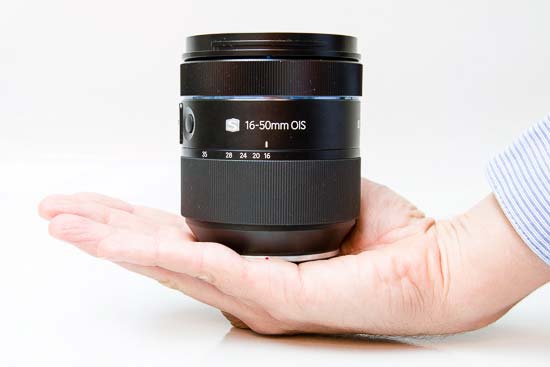 The Samsung S 16-50mm f/2-2.8 ED OIS lens in-hand
The Samsung S 16-50mm f/2-2.8 ED OIS lens in-hand
 The Samsung S 16-50mm f/2-2.8 ED OIS lens with the supplied lens hood fitted
The Samsung S 16-50mm f/2-2.8 ED OIS lens with the supplied lens hood fitted
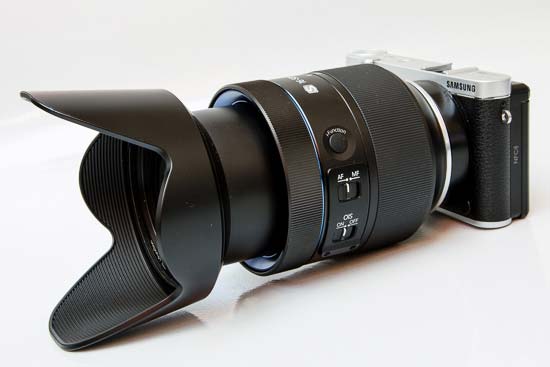 The Samsung S 16-50mm f/2-2.8 ED OIS lens with the supplied lens hood fitted
The Samsung S 16-50mm f/2-2.8 ED OIS lens with the supplied lens hood fitted
The Samsung S 16-50mm f/2-2.8 ED OIS comes with a large petal-shaped lens hood and a luxurious padded lens bag as standard.
Focal Range
At the 16mm end of the zoom range, the angle of view is 82.6°, equivalent to that of a 24mm lens in a 35mm system.
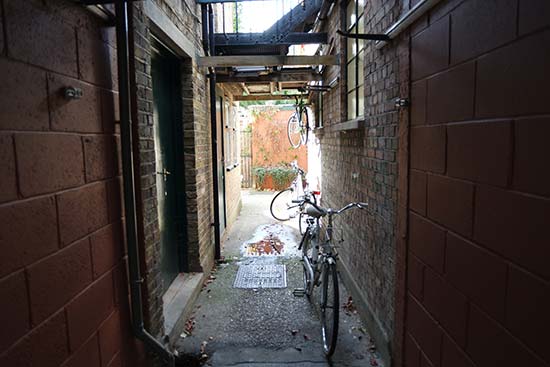 Field of view at 16mm
Field of view at 16mm
At the 50mm end, the angle of view narrows to 31.4°, which is the same as that of a 75mm lens on a 35mm full-frame camera.
 Field of view at 50mm
Field of view at 50mm
Focusing
With the lens attached to an NX3000 body, auto-focus is surprisingly fast, more than capable of keeping quickly and erratically moving subjects in focus. Thankfully the filter thread does not rotate on focus, making it that much easier to use graduated neutral density filters and polarisers. The lens takes 81mm filters.
Manual focusing is also possible via the smooth and generously sized focus ring located close to the end of the lens. For an AF lens, the focus ring has a fairly generous amount of travel, which makes it easier to set focus precisely.
Distortion
At the 16mm setting, there is some barrel distortion, as demonstrated in the photo above. This turns into mild pincushion distortion in the telephoto range.
 Distortion at 16mm
Distortion at 16mm
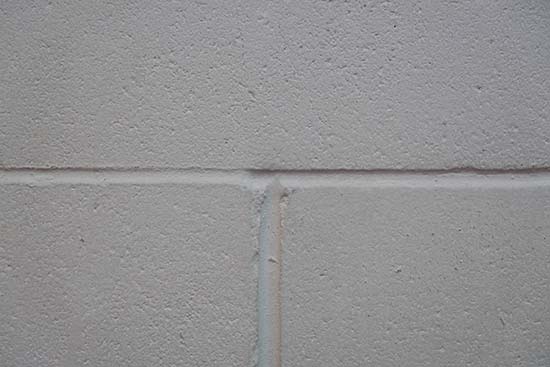 Distortion at 50mm
Distortion at 50mm
Chromatic Aberrations
Lateral chromatic aberrations, typically seen as purple or blue fringes in the peripheral areas of the image, are very well controlled with this lens. The 100% crops below give you an idea of what you should expect in the worst case.
 |
 |
Macro
This is not a macro lens. The maximum magnification of the Samsung S 16-50mm f/2-2.8 ED OIS is 0.19x and the closest focusing distance is 30cm. The following image illustrates how close you can get to the subject; in this case, a Compact Flash card.
 Close-up performance
Close-up performance
Bokeh
Bokeh is a word used for the out-of-focus areas of a photograph, and is usually described in qualitative terms, such as smooth / creamy / harsh etc. In the S 16-50mm f/2-2.8 ED OIS, Samsung employed an iris diaphragm with 9 blades, which has resulted in a very nice bokeh, at least in our opinion. However, recognising that bokeh evaluation is subjective, we have provided a few examples for your perusal.
 |
 |
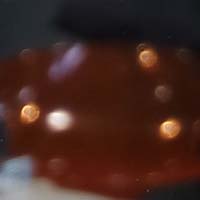 |
 |
Sharpness
In order to show you how sharp this lens is, we are providing 100% crops on the following pages.
